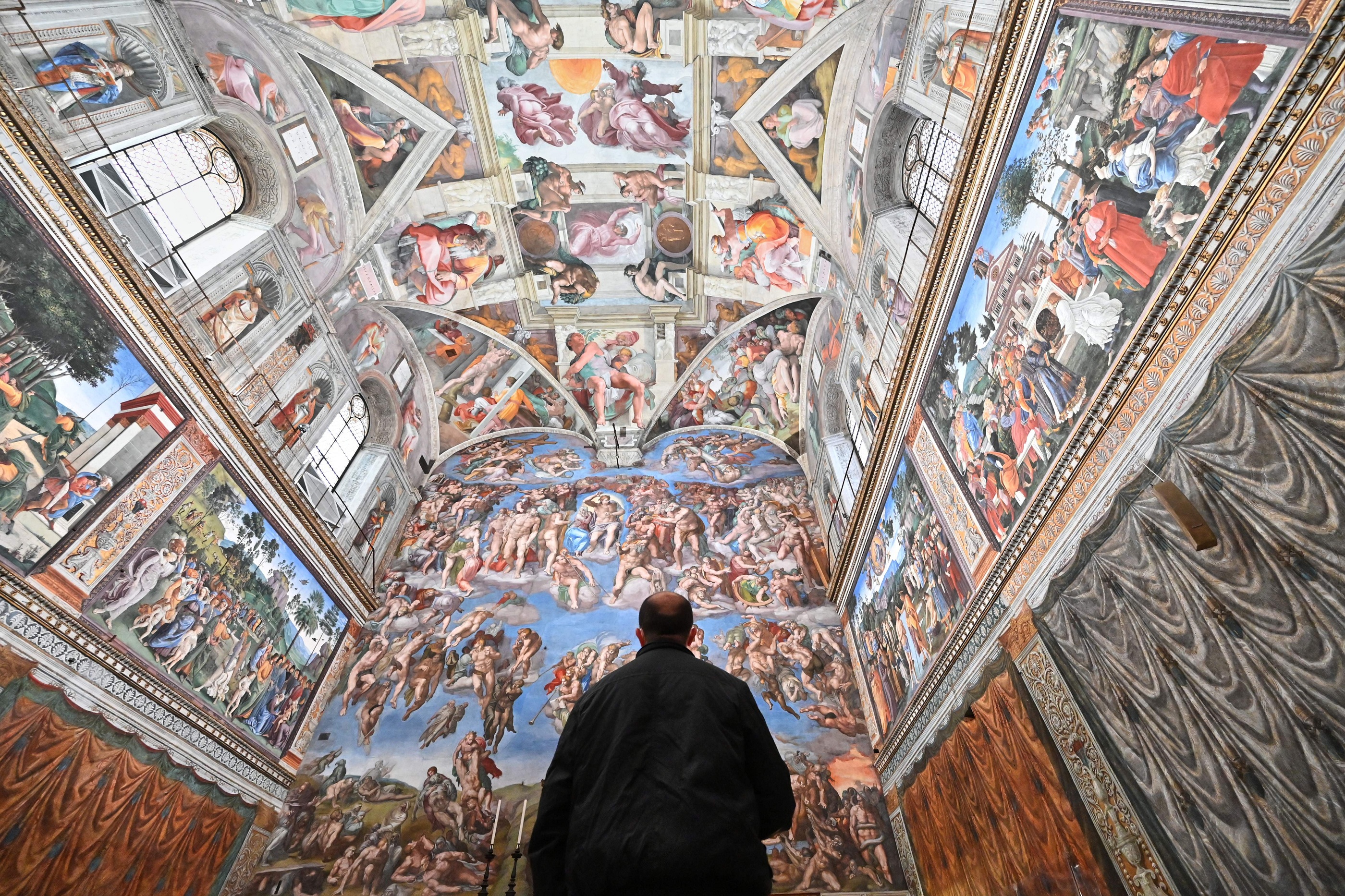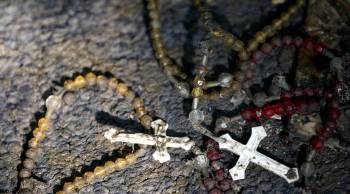
How much money does “God” have?

This is just one of the stories from our “I’ve Always Wondered” series, where we tackle all of your questions about the world of business, no matter how big or small. Ever wondered if recycling is worth it? Or how store brands stack up against name brands? Check out more from the series here.
Listener Jason Mudd from Amelia Island, Florida, asks:
When people say, “more money than God,” what might be a real number for that amount of money on Earth that God has? I’m thinking of the entire income and assets for all faith organizations, including houses of worship, faith charities, etc. How might we estimate that and compare it to large nations’ GDPs, the world’s wealthiest billionaires and our national debt?
If you’re looking at the Catholic Church alone, “God” has at least — and we’re putting a huge emphasis on “at least” — $73 billion in assets. Make that $73,000,000,001.07.
That makes the church almost as rich as Michael Bloomberg, about as rich as the state of Rhode Island, and wealthier than Ivory Coast, Uzbekistan or Croatia.
We decided to look at the Catholic Church because with 1.36 billion members around the world, Catholics make up the biggest denomination in the biggest religious group on the planet. It’s also one of the wealthiest.
The church has vast assets, including billions in real estate and some priceless art, not to mention the Vatican Bank. But its finances are largely secret. Tallying that immense wealth is pretty much impossible, according to experts.
There are also national churches in countries like the United States and Germany, which have decentralized economic systems, said Jason Berry, an investigative reporter who wrote the book “Render Unto Rome: The Secret Life of Money in the Catholic Church.”
“In other words, the Archdiocese of New York will have so many churches, so many schools, so many hospitals, it owns so much real estate,” Berry said. “But very few of the dioceses issue financial statements that would pass muster with a CPA.”
With those caveats in mind, here’s what we do know about the Catholic Church’s wealth.
Churches in Australia, Germany and the U.S.
A 2018 investigation by The Age, an Australian newspaper, found that the assets and investments of the Australian Catholic Church in the state of Victoria were worth more than $9 billion in Australian dollars.
The Age extrapolated from that figure that the church holds more than $30 billion AUD in assets across Australia. That’s roughly $25 billion in U.S. dollars, adjusted for inflation.
“Based on these figures, the church is clearly the largest non-government property owner, by value, in the state, and close to the largest in Australia,” The Age wrote.
Handelsblatt, a German newspaper, also reported in 2017 that Germany’s Catholic dioceses hold almost $33 billion, adjusted for inflation.
Trinity Church alone has a portfolio worth $6 billion, The New York Times reported in 2019. That’s roughly $7 billion in 2023 dollars for the historic New York church.
The New York Times noted the church is a developer, with a real estate arm that “controls ground leases and office space rentals in the buildings it owns.”
Value: Roughly $65 billion
The Vatican Bank and the Holy See’s assets
Financial statements from 2021 show that the Institute for the Works of Religion, also known as the Vatican Bank, earned a net profit of 18.1 million euros and had a total of roughly 2.8 billion euros in assets, which amounts to more than $3 billion after adjusting for inflation.
The Vatican City bank is a private financial institution, with no branches, that’s been at the center of several financial scandals. In recent years, the church has worked to reform it.
And last year, the Vatican’s former finance minister, Father Juan Antonio Guerrero Alves, spoke with the Vatican News about the Holy See’s financial statements for 2021, revealing that it had 3.9 billion euros in total assets. Adjusted for 2023 dollars, that’s almost $5 billion.
Value: $8 billion
The Vatican museums
The Vatican houses tens of thousands of pieces of art in its 26 museums, including the Sistine Chapel, which contains works from some of the most renowned artists in history.
There’s Raphael’s fresco “The School of Athens” and Michelangelo’s fresco “The Creation of Adam.” In 2004, a Vatican accountant said that St. Peter’s Basilica and the Sistine Chapel were priceless and “listed at a symbolic 1 euro” (or $1.07).
Some pieces are easier to put a price tag on compared to others, like Vincent Van Gogh’s “Pieta,” a 41.5 cm X 34 cm painting that shows the Virgin Mary and Jesus Christ after his crucifixion. This is a piece that is portable and entered the collection “in modern times,” explained art dealer Robert Simon, owner of Robert Simon Fine Art in New York City.
“Not a typical work for the artist, and a lot less appealing in the marketplace than most works by the artist due to its religious subject, but great provenance for sure,” Simon said.
So this painting might go for “only” $40 million to $50 million, he said by email.
Like the church’s other assets, Simon said trying to assess the value of the Catholic Church’s art is an “impossible” task.
“And this is coming from a long-time art appraiser who has valued so-called ‘priceless’ works of art, including ones by Leonardo and Raphael,” Simon said.
Some of the art is part of the physical structure of its buildings, like the paintings on the Sistine Chapel. If you somehow “liberated” some of the artwork from the structures they’re a part of, they’d reach “stratospheric prices,” Simon said.
“And there are many, many other cultural treasures — thousands upon thousands — of ‘priceless’ value in the Vatican collections: paintings, frescoes, sculptures, books, manuscripts, antiquities,” he added.
You also have to consider adding up the other art the Catholic Church owns beyond the Vatican.
“But before being horrified by the immense wealth implicit in all of this, it is best to remember that as much as it is all officially ‘owned’ by a single entity, it really belongs to all of us, whatever one’s faith,” Simon said. “It is like the Statue of Liberty, the Taj Mahal, the Eiffel Tower, the British Museum or Niagara Falls. They are all owned by some entity, and I suspect there are insurance values placed on each, but they are really part of our civilization’s wealth — and are really inseparable from that.”
Value: $1.07 – priceless
Other incalculable assets
The Catholic Church’s property across the globe spans nearly 277,000 square miles, which is just about the size of Texas, said Gerald Posner, author of “God’s Bankers: A History of Money and Power at the Vatican.”
“That includes embassies, churches, cathedrals, monastery schools and convents,” Posner said.
And some of that real estate is very valuable. Take St. Patrick’s Cathedral in New York, for example. Just imagine how much a developer would value that land, which is in the heart of Fifth Avenue, he said.
“So we’re talking billions and billions of dollars in terms of real estate,” Posner noted.
Posner said that he’s tried to get a valuation on the Catholic Church’s property from tax authorities.
“We know tax appraisals for property are often less than the real value of the property if it were sold,” Posner said. “But they don’t even have that. Since it’s a tax-exempt property, nobody in the government wastes time trying to come up with a valuation.”
In the U.S., churches “are generally exempt from income tax,” according to the Internal Revenue Service.
Posner said he was raised Catholic and remembers the parish priest was always bringing up how poor the church was and how they didn’t have enough money for renovations.
“So they get people to contribute money by saying, ‘We need money,’” he said, noting that the last thing the Catholic Church wants is media reporting on its wealth, which is why it’s never flashy about it.
“They don’t brag about what they have, they try to downplay it all the time,” he said.
But Posner said he thinks the Vatican is “straightening out its house in terms of finance” — and that’s all thanks to the euro, which it adopted in the early 2000s.
“What they didn’t realize then is that by going with the euro, they agreed to Brussels doing oversight on their central bank and making sure that they were compliant with international banking rules,” Posner said.
So we have entered a period of greater transparency with the Catholic Church. But it’s likely we’ll never truly know the extent of its assets.
There’s a lot happening in the world. Through it all, Marketplace is here for you.
You rely on Marketplace to break down the world’s events and tell you how it affects you in a fact-based, approachable way. We rely on your financial support to keep making that possible.
Your donation today powers the independent journalism that you rely on. For just $5/month, you can help sustain Marketplace so we can keep reporting on the things that matter to you.


















